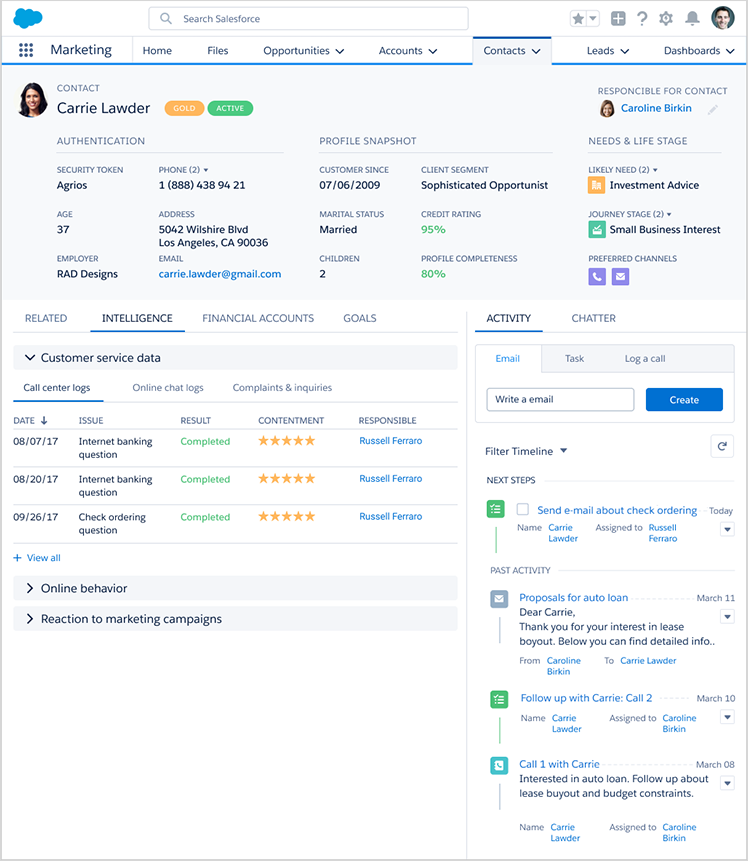Salesforce contact management: tips and ideas for effective customer communication
Editor's note: Want to set up effective contact management or maybe other workflows in your CRM system? A CRM services company that works with market-leading CRM platforms and custom solutions will help you with all your goals.
In our previous article, we’ve explained how Salesforce accounts help in building a 360-degree customer view. Though building a full-blown account database will significantly help you to gain knowledge about your clients, you’ll certainly need a place to store information about their individual employees. That is why we advise you to have a look at Contacts.

The use of contacts in Salesforce
Contacts help you maintain the information about key decision-makers, key buyers and other influencers for a Salesforce account.
- Your marketing team needs contacts to send them promotional materials about your company’s products and services.
- Your sales team needs contacts to connect with customers, show them demos and do any other activities to close the deal.
- Your customer service team needs them to solve customer-related issues in the most efficient way.
Components of a Salesforce contact record
The Salesforce contact object comes preconfigured with a standard set of fields, which can be further customized according to your preferences and needs. In the following list, you can find the default Salesforce contact fields you can fill in when creating a contact:
- First and last name
- Account name
- Job title
- Email address
- Phone number
- Fax
- Address
After you complete these most common fields, you can fill in the following data:
- Contact owner – indicates the person in your company who owns the contact. Though a contact can have only one owner, other users can still collaborate on it.
- Reports to field – allows organizing your contacts hierarchically.
- Lead source drop-down list – defines where the contact came from.
- Email opt out checkbox – reminds you whether a contact should be emailed.
- Do not call checkbox – reminds you whether a contact can be called.
N.B.: Be careful if one of your contacts said they don’t want to hear from you or receive any marketing materials, because your indifference to people’s privacy can spoil your customer relationships. However, even if you are diligent enough to use the email-opt-out and do-not-call checkboxes, you should also ensure that this information won’t be later uploaded to the mass email system.
If you need to know the behavior of your contacts in social networks, you can enable Social Accounts and Contacts feature in Salesforce. Turning on this feature, you’ll be able to see new data that your contacts post in Twitter, Facebook, Klout, and Youtube in appropriate Salesforce contact records.
Adding custom fields to the default contact page layout
Since the default contact page layout is general-purpose, it may not meet your specific needs. In this case, we advise adding a few custom fields to make you content page layout more suitable for you.
When customizing your Salesforce contact record, you should ask yourself the following questions:
- What professional information is important for my company (for example, prior employers or association membership)?
- What personal information do I need to improve customer relationship?
- How can I measure the strength of my relationship with contacts?
As a result, your customized Contacts object in Salesforce can look as follows:

Customized Salesforce contact object for retail banking. View full demo
N.B.: When adding a personal touch, try to keep your contact record simple. Otherwise, your sales reps may be unwilling to fill in so many details about your contacts. If you need to identify improvement areas or doubt about how to customize your contact page layout in the most effective way, we advise you to ask for Salesforce consulting.
Organizing your contacts
To add a new contact, you can start from scratch and manually create it in Salesforce. Alternatively, if you already have contacts in an Excel spreadsheet or somewhere else, you can use Salesforce Data import wizard.
Once you have your contacts in Salesforce, you can organize them in contact lists so that they bring more value to your selling process. A contact list view unites contacts that match certain criteria as well as limit the number of displayed contacts. For example, to wish your contacts a happy birthday, you can use a preset list view that displays contacts who have birthdays this month. Besides, you can generate a list of recently viewed contacts or contacts that have been created since the beginning of the week. In case you have special needs in tracking your contacts, you’re free to create custom list views.
N.B.: Don’t allow ‘orphan’ contacts. If you don’t associate contacts with corresponding accounts, they will be hidden from all users except their owner and your system administrator, which results in forgotten, hard to find and useless contacts.
Maintaining the integrity of your contact data in Salesforce
The rule of thumb in efficient Salesforce contact management is to have a single, complete, and accurate contact record for each person who is active with an account. Let’s see what each of these attributes implies:
- Single – you should have only one contact record for each person in Salesforce.
- Complete – each contact record should have as much information as possible.
- Accurate – you should reflect any changes in people’s contact details in Salesforce as early as possible.
- Active – means currently employed and actively working for a company. We advise to track the status of a particular contact with the ‘Active’ checkbox, because a person may be currently employed, but stay inactive (for example, if someone from your contact list is on maternity leave).
Thus, to maintain the integrity of you contact data, consider the following points:
- How will you identify inaccurate contact records?
- What will you do when you find duplicate contact records?
- How will you determine which information is correct?
Conclusion
Accounts and contacts are associated with many other standard Salesforce objects, which makes them some of the most important objects in Salesforce. Besides, both of them are the basis of building a 360-degree customer view. That is why a deep understanding of how to use accounts and contacts in the most efficient way is the key to your success among customers.

